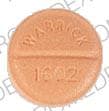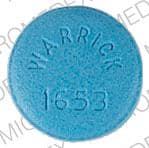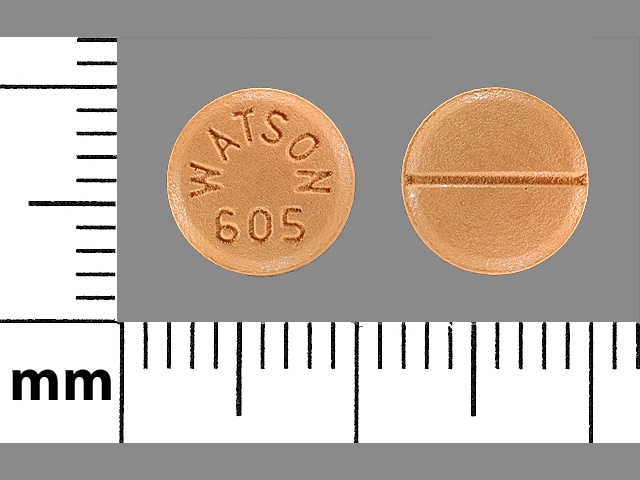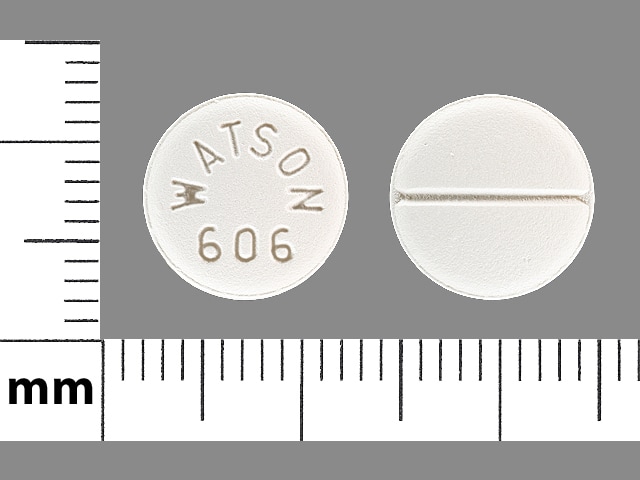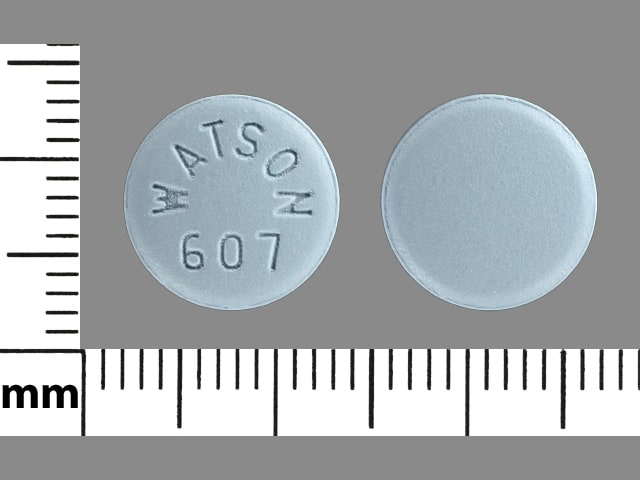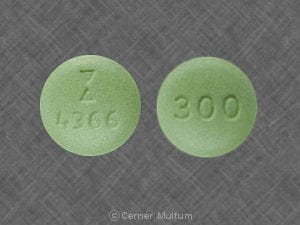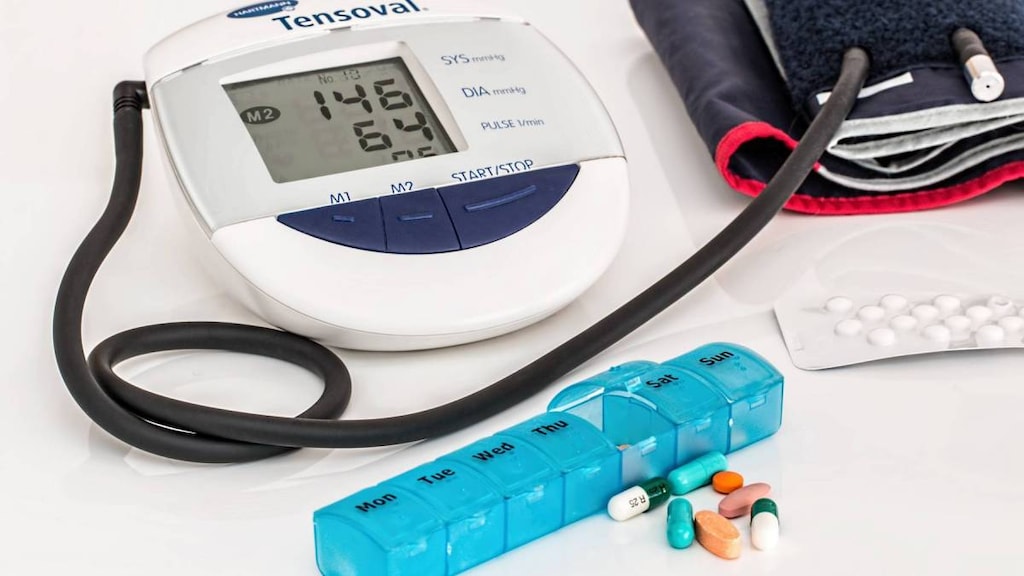Dosage Forms
Excipient information presented when available (limited, particularly for generics); consult specific product labeling.
Solution, Intravenous, as hydrochloride:
Generic: 5 mg/mL (4 mL, 20 mL, 40 mL)
Tablet, Oral, as hydrochloride:
Generic: 100 mg, 200 mg, 300 mg
Pharmacology
Mechanism of Action
Blocks alpha1-, beta1-, and beta2-adrenergic receptor sites; elevated renins are reduced. The ratios of alpha- to beta-blockade differ depending on the route of administration estimated to be 1:3 (oral) and 1:7 (IV) (Goa 1989).
Pharmacokinetics/Pharmacodynamics
Absorption
Complete
Distribution
Apparent Vd: Adults: 2.5 to 15.7 L/kg (Goa 1989)
Metabolism
Hepatic, primarily via glucuronide conjugation; extensive first-pass effect
Excretion
Urine (55% to 60% as glucuronide conjugates, <5% as unchanged drug [Goa 1989]); feces (12% to 27% as metabolites) (Goa 1989)
Onset of Action
Oral: 20 minutes to 2 hours (McNeil 1984); IV: Within 5 minutes (Goa 1989); Peak effect: Oral: 2 to 4 hours; IV: 5 to 15 minutes (Goa 1989)
Time to Peak
Plasma: Oral: 1 to 2 hours
Duration of Action
Blood pressure response:
Oral: 8 to 12 hours (dose dependent)
IV: Average: 16 to 18 hours (dose dependent)
Half-Life Elimination
Oral: 6 to 8 hours; IV: ~5.5 hours
Protein Binding
~50%
Use in Specific Populations
Special Populations: Elderly
Elimination is reduced in elderly patients.
Use: Labeled Indications
Hypertension: Management of hypertension (IV indicated for severe hypertension only [eg, hypertensive emergencies]). Note: Beta-blockers are not recommended as first-line therapy (ACC/AHA [Whelton 2018]).
Use: Off Label
Acute aortic syndromes/Acute aortic dissectionyes
The American College of Cardiology (ACC)/American Heart Association (AHA) guideline for the prevention, detection, evaluation, and management of high blood pressure in adults recommends labetalol as an antihypertensive treatment option for the management of blood pressure in patients with acute aortic dissection ACC/AHA [Whelton 2018].
Acute ischemic stroke, blood pressure managementyes
The AHA/American Stroke Association (ASA) guideline for the early management of patients with acute ischemic stroke recommends labetalol as an antihypertensive treatment option for the management of blood pressure before, during, and after reperfusion with a thrombolytic AHA/ASA [Powers 2019].
Hypertensive emergency in pregnancy or postpartum (including acute-onset hypertension in preeclampsia/eclampsia)yes
Based on the American College of Obstetricians and Gynecologists opinion on emergent therapy for acute-onset, severe hypertension during pregnancy and the postpartum period, the use of labetalol is effective and recommended as a treatment option in pregnant and postpartum patients who are experiencing acute-onset, severe hypertension with preeclampsia or eclampsia ACOG 767 2019.
Intracerebral hemorrhage, blood pressure managementcyes
Data from a retrospective chart review of patients with intracerebral hemorrhage or subarachnoid hemorrhage suggest that labetalol is effective and safe for the management of blood pressure in this population Ortega-Gutierrez 2013.
The ACC/AHA guideline for the prevention, detection, evaluation, and management of high blood pressure in adults and the AHA/ASA guideline for the management of spontaneous intracerebral hemorrhage recommend labetalol as an antihypertensive treatment option for the management of blood pressure in patients with intracerebral hemorrhage ACC/AHA [Whelton 2018], AHA/ASA [Hemphill 2015].
Subarachnoid hemorrhage, blood pressure managementcyes
Data from prospective and retrospective clinical trials and institutional experience are generally supportive of labetalol use in patients with subarachnoid hemorrhage (SAH) for blood pressure management Liu-DeRyke 2013, Ortega-Gutierrez 2013, Patel 1993, Woloszyn 2012. Nicardipine appears to have more beneficial outcomes than sodium nitroprusside and labetalol; however, only a small number of studies have compared the agents directly.
The AHA/ASA guideline for the management of aneurysmal subarachnoid hemorrhage recommends the use of antihypertensives during the period between onset of SAH and surgical obliteration. Treatment of high blood pressure is also recommended to prevent ischemic stroke, intracerebral hemorrhage, and end-organ injury AHA/ASA [Connolly 2012].
Contraindications
Hypersensitivity to labetalol or any component of the formulation; severe bradycardia; heart block greater than first degree (except in patients with a functioning artificial pacemaker); cardiogenic shock; bronchial asthma or a history of obstructive airway disease; uncompensated cardiac failure; conditions associated with severe and prolonged hypotension
Documentation of allergenic cross-reactivity for alpha/beta adrenergic blocking agents is limited. However, because of similarities in chemical structure and/or pharmacologic actions, the possibility of cross-sensitivity cannot be ruled out with certainty.
Dosage and Administration
Dosing: Adult
Note: IV administration: There is limited documentation of prolonged continuous infusions; most patients respond to initial IV bolus dosing and are then transitioned to an oral antihypertensive (Huey 1988; Papademetriou 1982; Wright 1986). Accumulation can occur with high-dose continuous infusions and may result in severe hypotension and bradycardia (Fahed 2008).
Acute aortic syndromes/Acute aortic dissection (alternative agent) (off-label use):
Note: Manage patients immediately (including operative assessment) by controlling heart rate (target <60 bpm), pain with IV opioids, and systolic BP (target 100 to 120 mm Hg or lowest tolerated pressure) (ACCF/AHA [Hiratzka 2010]; Black 2019). Although manufacturer's labeling recommends against exceeding a cumulative IV dose of 300 mg, it may be reasonable to exceed this dose in selected patients, while monitoring for accumulation (Goldsmith 1990).
Intermittent IV: Initial: 20 mg over 2 minutes; followed by 20 to 80 mg every 10 minutes until target heart rate and blood pressure is reached; may transition to continuous infusion if unable to obtain target goals (ACC/AHA [Whelton 2018]; Black 2019; MacCarthy 1983; Marik 2011; Peacock 2012; Sarafidis 2012).
Continuous IV infusion: Initial loading dose: 20 mg over 2 minutes (optional if intermittent dosing is used), followed by 0.5 to 2 mg/minute; some patients may require titration up to 10 mg/minute for optimal response (ACC/AHA [Whelton 2018]; Black 2019; Marik 2007; Marik 2011; Peixoto 2019; Sarafidis 2012).
Acute ischemic stroke, blood pressure management (off-label use):
Patient otherwise eligible for reperfusion treatment (eg, alteplase) except BP >185/110 mm Hg:
IV: 10 to 20 mg over 1 to 2 minutes; may repeat once. If BP remains >185/110 mm Hg, do not administer thrombolytic (ACC/AHA [Whelton 2018]; AHA/ASA [Powers 2019]).
Management of blood pressure during and after reperfusion treatment (eg, alteplase):
IV: 10 mg over 1 to 2 minutes, followed by 2 to 8 mg/minute continuous infusion. Target BP <180/105 mm Hg for first 24 hours after reperfusion treatment. If hypertension is refractory or diastolic BP >140 mm Hg, consider alternative therapy (ACC/AHA [Whelton 2018]; AHA/ASA [Powers 2019]). Although manufacturer's labeling recommends against exceeding a cumulative IV dose of 300 mg, it may be reasonable to exceed this dose in selected patients, while monitoring for accumulation (Goldsmith 1990).
Hypertension, acute/severe inpatient (including perioperative hypertension):
Note: The benefit of using IV antihypertensive agents to treat acute severe asymptomatic hypertension is not well established; in general, address underlying causes (eg, pain, agitation, withdrawal, hypervolemia) prior to initiating antihypertensive therapy. Rapid or excessive blood pressure reduction may be associated with severe adverse effects (eg, cerebral or myocardial ischemia) (Axon 2015; Stanistreet 2020; Varon 2019). For patients with chronic hypertension prior to surgery, restart oral therapies as soon as appropriate once hemodynamically stable (Bisognano 2019; Lien 2012).
Intermittent IV: Initial: 5 to 20 mg over 2 minutes; repeat dose every 10 minutes until target blood pressure is reached (Bisognano 2019; London 2019; MacCarthy 1983; Mann 2019; manufacturer's labeling). Although manufacturer's labeling recommends against exceeding a cumulative IV dose of 300 mg, it may be reasonable to exceed this dose in selected patients, while monitoring for accumulation (Goldsmith 1990).
Hypertension, chronic/resistant:
Note: Not recommended for initial management of hypertension, but may be considered as additional therapy in patients who do not respond adequately to combination therapy with preferred agents (ACC/AHA [Whelton 2018]).
Oral: Initial: 100 mg twice daily; may increase as needed every 2 to 3 days by 100 mg twice daily (titration increments not to exceed 200 mg twice daily) until desired response is obtained; usual dosage range: 200 to 800 mg/day in 2 divided doses (ACC/AHA [Whelton 2018]). In patients with severe or resistant hypertension, doses up to 1.2 to 2.4 g/day in 2 or 3 divided doses may be required according to the manufacturer's labeling; however, some experts prefer combinations of agents dosed within usual range rather than further dose escalation (ACC/AHA [Whelton 2018]; Calhoun 2019; MacCarthy 1983).
Hypertensive emergency:
Note: In general, reduce mean arterial BP ~10% to 20% over the first hour, then 5% to 15% over the next 23 hours, unless there is a compelling indication (eg, acute aortic dissection, severe preeclampsia, eclampsia) for more rapid blood pressure and heart rate control (ACC/AHA [Whelton 2018]; Elliott 2019a). Although manufacturer's labeling recommends against exceeding a cumulative IV dose of 300 mg, it may be reasonable to exceed this dose in selected patients, while monitoring for accumulation (Goldsmith 1990).
Intermittent IV: Initial: 10 to 20 mg over 1 to 2 minutes; followed by 20 to 80 mg every 10 minutes until target blood pressure is reached; consider a continuous infusion if unable to obtain target blood pressure (ACC/AHA [Whelton 2018]; Cannon 2013; Elliott 2019b; MacCarthy 1983; Marik 2011; Peacock 2012; Sarafidis 2012).
Continuous IV infusion: Initial loading dose: 10 to 20 mg over 2 minutes (optional if intermittent dosing is used), followed by 0.5 to 2 mg/minute; some patients may require titration up to 10 mg/minute (ACC/AHA [Whelton 2018]; Marik 2007; Marik 2011; Peixoto 2019; Sarafidis 2012).
Hypertensive emergency in pregnancy or postpartum (including acute-onset hypertension in preeclampsia/eclampsia) (off-label use):
Note: For acute-onset, severe, persistent (eg, ≥15 minutes) hypertension (ACOG 767 2019). Although manufacturer's labeling recommends against exceeding a cumulative IV dose of 300 mg, it may be reasonable to exceed this dose in selected patients, while monitoring for accumulation (Goldsmith 1990).
Intermittent IV: Initial: 20 mg over 2 minutes; if blood pressure exceeds thresholds after 10 minutes, increase dose in increments of 20 to 40 mg every 10 minutes; maximum single dose: 80 mg. Note: If blood pressures remain above threshold after several intermittent doses, another agent should be used (ACOG 767 2019; ACOG 202 2019; Magee 2014).
Continuous IV infusion: Initial loading dose: 20 mg over 2 minutes (optional if intermittent dosing is used), followed by 1 to 2 mg/minute titrated to response (ACOG 202 2019; Magee 2014).
Oral (alternative route): Initial: 200 mg every 12 hours. Dose may be increased up to 800 mg every 8 to 12 hours as needed based on response and tolerability. Maximum: 2.4 g/day. IV therapy may be needed for acute treatment; combination therapy with another agent may be needed if maximum dose is ineffective or must be limited due to adverse effects (ACOG 202 2019).
Intracerebral hemorrhage, blood pressure management (off-label use):
Note: In patients who present within 6 hours of acute intracranial hemorrhage and have systolic BP between 150 and 220 mm Hg, decreasing systolic BP to <140 mm Hg is not beneficial and can be harmful (ACC/AHA [Whelton 2018]). Although manufacturer's labeling recommends against exceeding a cumulative IV dose of 300 mg, it may be reasonable to exceed this dose in selected patients, while monitoring for accumulation (Goldsmith 1990).
Patients who present with systolic BP >150 mm Hg:
Intermittent IV: Initial: 5 to 20 mg IV push over 2 minutes, followed by 20 to 80 mg every 10 to 15 minutes until recommended target systolic BP is reached; may consider a continuous infusion if unable to obtain target goals (AHA/ASA [Broderick 2007]; AHA/ASA [Hemphill 2015]; Rordorf 2019; Rose 2004).
Patients who present with systolic BP >220 mm Hg:
Continuous IV infusion: Initial loading dose: 20 mg over 2 minutes, followed by 0.5 to 2 mg/minute, titrate to recommended target systolic BP (AHA/ASA [Broderick 2007]; Mocco 2006; Ortega-Gutierrez 2013; Rordorf 2019; Rose 2004).
Subarachnoid hemorrhage, blood pressure management (off-label use):
Note: Optimal therapy is not well established. Cautious use of antihypertensive therapy to decrease the risk of rebleeding may be appropriate in some patients with systolic BP >160 mm Hg or mean arterial pressure >110 mm Hg with adequate cerebral perfusion pressures (AHA/ASA [Connolly 2012]; Singer 2019). Although manufacturer's labeling recommends against exceeding a cumulative IV dose of 300 mg, it may be reasonable to exceed this dose in selected patients, while monitoring for accumulation (Goldsmith 1990).
Intermittent IV: Initial: 10 to 20 mg over 2 minutes; followed by 20 to 80 mg every 10 to 15 minutes until systolic BP <160 mm Hg or mean arterial pressure <100 mm Hg (Liu-DeRyke 2013; Mocco 2006; Patel 1993; Woloszyn 2012).
Continuous IV infusion: 0.5 to 2 mg/minute titrated to response; based on very limited data (Mocco 2006).
IV to oral conversion:
Upon discontinuation of continuous IV infusion, may initiate oral dose of 200 mg followed in 6 to 12 hours with an additional dose of 200 to 400 mg; adjust dose based on response at ≥1-day intervals to a range of 400 mg/day to 2.4 g/day in 2 to 3 divided doses. Note: For hypertension, the usual dosage range is 200 to 800 mg/day in 2 divided doses (ACC/AHA [Whelton 2018]).
Dosing: Geriatric
Refer to adult dosing.
Hypertension: Oral:
Manufacturer's labeling: Initial: 100 mg twice daily; may titrate in increments of 100 mg twice daily; usual maintenance: 100 to 200 mg twice daily
ACCF/AHA Expert Consensus recommendations: Consider lower initial doses and titrating to response (Aronow 2011)
Dosing: Pediatric
Note: Use care with labetalol continuous IV infusions; the rate of administration is different for pediatric patients (mg/kg/hour) versus adult patients (mg/minute).
Hypertension: Children and Adolescents: Limited data available:
Oral: Initial: 1 to 3 mg/kg/day in 2 divided doses; maximum daily dose: 10 to 12 mg/kg/day, up to 1,200 mg/day (NHLBI 2011)
IV (intermittent bolus): 0.2 to 1 mg/kg/dose; maximum dose: 40 mg/dose; use should be reserved for severe hypertension (NHBPEP 2004)
Hypertensive emergency/urgency: Limited data available: Infants, Children, and Adolescents:
IV (intermittent bolus): 0.2 to 1 mg/kg/dose; maximum dose: 40 mg/dose (Flynn 2009)
Continuous IV infusion: 0.25 to 3 mg/kg/hour; initiate at lower end of range, and titrate up slowly (Flynn 2009; NHBPEP 2004). One retrospective study in infants and children ≤24 months of age observed reductions in blood pressure at doses up to 0.59 mg/kg/hour with little additional benefit at higher doses (Thomas 2011).
Reconstitution
Parenteral: Continuous IV infusion: Further dilute in a compatible solution (eg, D5W, NS) to a concentration of 1 mg/mL; higher concentrations up to 3.75 mg/mL have been shown to be stable (Yuen 1983).
Extemporaneously Prepared
40 mg/mL Oral Suspension (ASHP Oral Suspension) (ASHP 2017)
A 40 mg/mL labetalol hydrochloride oral suspension may be made with tablets and one of three different vehicles (cherry syrup, a 1:1 mixture of Ora-Sweet and Ora-Plus, or a 1:1 mixture of Ora-Sweet SF and Ora-Plus). Crush sixteen 300 mg tablets in a mortar and reduce to a fine powder. Add 20 mL of the chosen vehicle and mix to a uniform paste; mix while adding the vehicle in incremental proportions to almost 120 mL; transfer to a calibrated bottle, rinse mortar with vehicle, and add quantity of vehicle sufficient to make 120 mL. Label "shake well" and "protect from light." Stable for 60 days when stored in amber plastic prescription bottles in the dark at room temperature or refrigerated (Allen 1996).
Allen LV Jr and Erickson MA 3rd. Stability of Labetalol Hydrochloride, Metoprolol Tartrate, Verapamil Hydrochloride, and Spironolactone with Hydrochlorothiazide in Extemporaneously Compounded Oral Liquids. Am J Health Syst Pharm. 1996;53(19):2304-2309.8893069
10 mg/mL Oral Suspension
A 10 mg/mL labetalol hydrochloride oral suspension may be made with tablets and simple syrup. Crush twelve 100 mg tablets in a mortar and reduce to a fine powder. Add a small quantity of simple syrup and mix to a uniform paste; mix while adding the vehicle in incremental proportions to almost 120 mL; transfer to a calibrated bottle, rinse mortar with simple syrup, and add sufficient quantity to make 120 mL. Label "shake well" and "refrigerate." Stable for 4 weeks when stored under refrigeration (preferred) or at room temperature (Nahata 1991; Nahata 2014).
Nahata MC. Stability of Labetalol Hydrochloride in Distilled Water, Simple Syrup, and Three Fruit Juices. DICP. 1991;25(5):465-469.Nahata MC, Pai VB. Pediatric Drug Formulations. 6th ed, Cincinnati, OH: Harvey Whitney Books Co, 2014.
Administration
Oral: Administer without regard to food; however, the absolute bioavailability of labetalol is increased when administered with food. Administer in a consistent manner with regards to meals.
Parenteral: Bolus dose may be administered IV push at a rate of 10 mg/minute; may follow with continuous IV infusion
Storage
Tablets: Store between 2°C and 30°C (36°F and 86°F). Protect from light and excessive moisture.
Injectable: Store between 20°C and 25°C (68°F and 77°F); do not freeze. Protect from light.
Parenteral admixture: Stability of parenteral admixture at room temperature (25°C [77°F]) and refrigeration temperature (4°C [39°F]): 3 days (Yuen 1983).
Labetalol Images
Drug Interactions
Acetylcholinesterase Inhibitors: May enhance the bradycardic effect of Beta-Blockers. Monitor therapy
Alfuzosin: May enhance the hypotensive effect of Blood Pressure Lowering Agents. Monitor therapy
Alpha1-Blockers: Beta-Blockers may enhance the orthostatic hypotensive effect of Alpha1-Blockers. The risk associated with ophthalmic products is probably less than systemic products. Monitor therapy
Alpha2-Agonists: May enhance the AV-blocking effect of Beta-Blockers. Sinus node dysfunction may also be enhanced. Beta-Blockers may enhance the rebound hypertensive effect of Alpha2-Agonists. This effect can occur when the Alpha2-Agonist is abruptly withdrawn. Management: Closely monitor heart rate during treatment with a beta blocker and clonidine. Withdraw beta blockers several days before clonidine withdrawal when possible, and monitor blood pressure closely. Recommendations for other alpha2-agonists are unavailable. Exceptions: Apraclonidine. Consider therapy modification
Amifostine: Blood Pressure Lowering Agents may enhance the hypotensive effect of Amifostine. Management: When amifostine is used at chemotherapy doses, blood pressure lowering medications should be withheld for 24 hours prior to amifostine administration. If blood pressure lowering therapy cannot be withheld, amifostine should not be administered. Consider therapy modification
Aminoquinolines (Antimalarial): May decrease the metabolism of Beta-Blockers. Monitor therapy
Amiodarone: May enhance the bradycardic effect of Beta-Blockers. Possibly to the point of cardiac arrest. Amiodarone may increase the serum concentration of Beta-Blockers. Monitor therapy
Amphetamines: May diminish the antihypertensive effect of Antihypertensive Agents. Monitor therapy
Antipsychotic Agents (Phenothiazines): May enhance the hypotensive effect of Beta-Blockers. Beta-Blockers may decrease the metabolism of Antipsychotic Agents (Phenothiazines). Antipsychotic Agents (Phenothiazines) may decrease the metabolism of Beta-Blockers. Monitor therapy
Antipsychotic Agents (Second Generation [Atypical]): Blood Pressure Lowering Agents may enhance the hypotensive effect of Antipsychotic Agents (Second Generation [Atypical]). Monitor therapy
Barbiturates: May decrease the serum concentration of Beta-Blockers. Monitor therapy
Barbiturates: May enhance the hypotensive effect of Blood Pressure Lowering Agents. Monitor therapy
Benperidol: May enhance the hypotensive effect of Blood Pressure Lowering Agents. Monitor therapy
Beta2-Agonists: Beta-Blockers (Nonselective) may diminish the bronchodilatory effect of Beta2-Agonists. Avoid combination
Bradycardia-Causing Agents: May enhance the bradycardic effect of other Bradycardia-Causing Agents. Monitor therapy
Brigatinib: May diminish the antihypertensive effect of Antihypertensive Agents. Brigatinib may enhance the bradycardic effect of Antihypertensive Agents. Monitor therapy
Brimonidine (Topical): May enhance the hypotensive effect of Blood Pressure Lowering Agents. Monitor therapy
Bromperidol: Blood Pressure Lowering Agents may enhance the hypotensive effect of Bromperidol. Bromperidol may diminish the hypotensive effect of Blood Pressure Lowering Agents. Avoid combination
Bupivacaine: Beta-Blockers may increase the serum concentration of Bupivacaine. Monitor therapy
Calcium Channel Blockers (Nondihydropyridine): May enhance the hypotensive effect of Beta-Blockers. Bradycardia and signs of heart failure have also been reported. Calcium Channel Blockers (Nondihydropyridine) may increase the serum concentration of Beta-Blockers. Exceptions: Bepridil. Monitor therapy
Cardiac Glycosides: Beta-Blockers may enhance the bradycardic effect of Cardiac Glycosides. Monitor therapy
Ceritinib: Bradycardia-Causing Agents may enhance the bradycardic effect of Ceritinib. Management: If this combination cannot be avoided, monitor patients for evidence of symptomatic bradycardia, and closely monitor blood pressure and heart rate during therapy. Exceptions are discussed in separate monographs. Consider therapy modification
Cholinergic Agonists: Beta-Blockers may enhance the adverse/toxic effect of Cholinergic Agonists. Of particular concern are the potential for cardiac conduction abnormalities and bronchoconstriction. Monitor therapy
Dexmethylphenidate: May diminish the therapeutic effect of Antihypertensive Agents. Monitor therapy
Diazoxide: May enhance the hypotensive effect of Blood Pressure Lowering Agents. Monitor therapy
Dipyridamole: May enhance the bradycardic effect of Beta-Blockers. Monitor therapy
Disopyramide: May enhance the bradycardic effect of Beta-Blockers. Beta-Blockers may enhance the negative inotropic effect of Disopyramide. Monitor therapy
Dronedarone: May enhance the bradycardic effect of Beta-Blockers. Dronedarone may increase the serum concentration of Beta-Blockers. This likely applies only to those agents that are metabolized by CYP2D6. Management: Use lower initial beta-blocker doses; adequate tolerance of the combination, based on ECG findings, should be confirmed prior to any increase in beta-blocker dose. Consider therapy modification
DULoxetine: Blood Pressure Lowering Agents may enhance the hypotensive effect of DULoxetine. Monitor therapy
EPINEPHrine (Nasal): Beta-Blockers (with Alpha-Blocking Properties) may diminish the therapeutic effect of EPINEPHrine (Nasal). Monitor therapy
EPINEPHrine (Oral Inhalation): Beta-Blockers (with Alpha-Blocking Properties) may diminish the therapeutic effect of EPINEPHrine (Oral Inhalation). Monitor therapy
Epinephrine (Racemic): Beta-Blockers (with Alpha-Blocking Properties) may diminish the therapeutic effect of Epinephrine (Racemic). Monitor therapy
EPINEPHrine (Systemic): Beta-Blockers (with Alpha-Blocking Properties) may diminish the therapeutic effect of EPINEPHrine (Systemic). Monitor therapy
Ergot Derivatives: Beta-Blockers may enhance the vasoconstricting effect of Ergot Derivatives. Exceptions: Nicergoline. Consider therapy modification
Fexinidazole [INT]: Bradycardia-Causing Agents may enhance the arrhythmogenic effect of Fexinidazole [INT]. Avoid combination
Fingolimod: Beta-Blockers may enhance the bradycardic effect of Fingolimod. Management: Avoid the concomitant use of fingolimod and beta-blockers if possible. If coadministration is necessary, patients should have overnight continuous ECG monitoring conducted after the first dose of fingolimod. Monitor patients for bradycardia. Consider therapy modification
Floctafenine: May enhance the adverse/toxic effect of Beta-Blockers. Avoid combination
Grass Pollen Allergen Extract (5 Grass Extract): Beta-Blockers may enhance the adverse/toxic effect of Grass Pollen Allergen Extract (5 Grass Extract). More specifically, Beta-Blockers may inhibit the ability to effectively treat severe allergic reactions to Grass Pollen Allergen Extract (5 Grass Extract) with epinephrine. Some other effects of epinephrine may be unaffected or even enhanced (e.g., vasoconstriction) during treatment with Beta-Blockers. Consider therapy modification
Herbs (Hypertensive Properties): May diminish the antihypertensive effect of Antihypertensive Agents. Monitor therapy
Herbs (Hypotensive Properties): May enhance the hypotensive effect of Blood Pressure Lowering Agents. Monitor therapy
Hypotension-Associated Agents: Blood Pressure Lowering Agents may enhance the hypotensive effect of Hypotension-Associated Agents. Monitor therapy
Insulins: Beta-Blockers may enhance the hypoglycemic effect of Insulins. Monitor therapy
Iobenguane Radiopharmaceutical Products: Labetalol may diminish the therapeutic effect of Iobenguane Radiopharmaceutical Products. Management: Discontinue all drugs that may inhibit or interfere with catecholamine transport or uptake for at least 5 biological half-lives before iobenguane administration. Do not administer labetalol until at least 7 days after each iobenguane dose. Avoid combination
Ivabradine: Bradycardia-Causing Agents may enhance the bradycardic effect of Ivabradine. Monitor therapy
Lacosamide: Bradycardia-Causing Agents may enhance the AV-blocking effect of Lacosamide. Monitor therapy
Levodopa-Containing Products: Blood Pressure Lowering Agents may enhance the hypotensive effect of Levodopa-Containing Products. Monitor therapy
Lidocaine (Systemic): Beta-Blockers may increase the serum concentration of Lidocaine (Systemic). Monitor therapy
Lidocaine (Topical): Beta-Blockers may increase the serum concentration of Lidocaine (Topical). Monitor therapy
Lormetazepam: May enhance the hypotensive effect of Blood Pressure Lowering Agents. Monitor therapy
Mepivacaine: Beta-Blockers may increase the serum concentration of Mepivacaine. Monitor therapy
Methacholine: Beta-Blockers may enhance the adverse/toxic effect of Methacholine. Monitor therapy
Methoxyflurane: May enhance the hypotensive effect of Beta-Blockers. Monitor therapy
Methylphenidate: May diminish the antihypertensive effect of Antihypertensive Agents. Monitor therapy
Midodrine: May enhance the bradycardic effect of Bradycardia-Causing Agents. Monitor therapy
Molsidomine: May enhance the hypotensive effect of Blood Pressure Lowering Agents. Monitor therapy
Naftopidil: May enhance the hypotensive effect of Blood Pressure Lowering Agents. Monitor therapy
Nicergoline: May enhance the hypotensive effect of Blood Pressure Lowering Agents. Monitor therapy
Nicorandil: May enhance the hypotensive effect of Blood Pressure Lowering Agents. Monitor therapy
NIFEdipine: May enhance the hypotensive effect of Beta-Blockers. NIFEdipine may enhance the negative inotropic effect of Beta-Blockers. Monitor therapy
Nitroprusside: Blood Pressure Lowering Agents may enhance the hypotensive effect of Nitroprusside. Monitor therapy
Nonsteroidal Anti-Inflammatory Agents: May diminish the antihypertensive effect of Beta-Blockers. Monitor therapy
Obinutuzumab: May enhance the hypotensive effect of Blood Pressure Lowering Agents. Management: Consider temporarily withholding blood pressure lowering medications beginning 12 hours prior to obinutuzumab infusion and continuing until 1 hour after the end of the infusion. Consider therapy modification
Opioids (Anilidopiperidine): May enhance the bradycardic effect of Beta-Blockers. Opioids (Anilidopiperidine) may enhance the hypotensive effect of Beta-Blockers. Monitor therapy
Pentoxifylline: May enhance the hypotensive effect of Blood Pressure Lowering Agents. Monitor therapy
Pholcodine: Blood Pressure Lowering Agents may enhance the hypotensive effect of Pholcodine. Monitor therapy
Phosphodiesterase 5 Inhibitors: May enhance the hypotensive effect of Blood Pressure Lowering Agents. Monitor therapy
Propafenone: May increase the serum concentration of Beta-Blockers. Propafenone possesses some independent beta blocking activity. Monitor therapy
Prostacyclin Analogues: May enhance the hypotensive effect of Blood Pressure Lowering Agents. Monitor therapy
Quinagolide: May enhance the hypotensive effect of Blood Pressure Lowering Agents. Monitor therapy
Regorafenib: May enhance the bradycardic effect of Beta-Blockers. Monitor therapy
Reserpine: May enhance the hypotensive effect of Beta-Blockers. Monitor therapy
Rifamycin Derivatives: May decrease the serum concentration of Beta-Blockers. Exceptions: Rifabutin. Monitor therapy
Rivastigmine: May enhance the bradycardic effect of Beta-Blockers. Avoid combination
Ruxolitinib: May enhance the bradycardic effect of Bradycardia-Causing Agents. Management: Ruxolitinib Canadian product labeling recommends avoiding use with bradycardia-causing agents to the extent possible. Monitor therapy
Siponimod: Bradycardia-Causing Agents may enhance the bradycardic effect of Siponimod. Management: Avoid coadministration of siponimod with drugs that may cause bradycardia. Consider therapy modification
Sulfonylureas: Beta-Blockers may enhance the hypoglycemic effect of Sulfonylureas. Cardioselective beta-blockers (eg, acebutolol, atenolol, metoprolol, and penbutolol) may be safer than nonselective beta-blockers. All beta-blockers appear to mask tachycardia as an initial symptom of hypoglycemia. Ophthalmic beta-blockers are probably associated with lower risk than systemic agents. Monitor therapy
Terlipressin: May enhance the bradycardic effect of Bradycardia-Causing Agents. Monitor therapy
Theophylline Derivatives: Beta-Blockers (Nonselective) may diminish the bronchodilatory effect of Theophylline Derivatives. Monitor therapy
Tofacitinib: May enhance the bradycardic effect of Bradycardia-Causing Agents. Monitor therapy
Yohimbine: May diminish the antihypertensive effect of Antihypertensive Agents. Monitor therapy
Test Interactions
False-positive urine catecholamines, metanephrine, normetanephrine, and vanillylmandelic acid (VMA) if measured by fluorometric or photometric methods (high performance liquid chromatographic [HPLC] assay with solid phase extraction should be used to determine levels of catecholamines); false-positive urine amphetamine if measured by thin-layer chromatography or radioenzymatic assay (gas chromatographic-mass spectrometer technique should be used); may lead to false-positive aldosterone/renin ratio (ARR) (Funder 2016)
Adverse Reactions
>10%:
Cardiovascular: Orthostatic hypotension (intravenous: 58%; tablet: 1%)
Central nervous system: Dizziness (1% to 20%), fatigue (1% to 11%)
Gastrointestinal: Nausea (≤19%)
1% to 10%:
Cardiovascular: Edema (1% to 2%), flushing (1%), hypotension (1%), ventricular arrhythmia (intravenous: 1%)
Central nervous system: Paresthesia (≤7%), drowsiness (≤3%), yawning (≤3%), headache (2%), vertigo (1% to 2%), hypoesthesia (1%)
Dermatologic: Diaphoresis (≤4%), pruritus (1%), skin rash (1%)
Gastrointestinal: Dyspepsia (≤4%), vomiting (≤4%), dysgeusia (1%)
Genitourinary: Ejaculatory failure (1% to 5%), impotence (1% to 4%)
Hepatic: Increased serum transaminases (4%)
Neuromuscular & skeletal: Asthenia (1%)
Ophthalmic: Visual disturbance (1%)
Renal: Increased blood urea nitrogen (≤8%), increased serum creatinine (≤8%)
Respiratory: Nasal congestion (1% to 6%), dyspnea (2%), wheezing (1%)
<1%, postmarketing, and/or case reports: Anaphylactoid reaction, angioedema, antibody development (antimitochondrial), bradycardia, bronchospasm, cardiac failure, cholestatic jaundice, diabetes mellitus, diarrhea, difficulty in micturition, facial erythema, fever, heart block, hepatic injury, hepatic necrosis, hepatitis, hypersensitivity reaction, increased liver enzymes, jaundice, lichenoid eruption, lichen planus, maculopapular rash, muscle cramps, myopathy, Peyronie disease, positive ANA titer, psoriasiform eruption, syncope, systemic lupus erythematosus, transient alopecia, urinary retention, urticaria, xerophthalmia
Warnings/Precautions
Concerns related to adverse effects:
- Anaphylactic reactions: Use caution with history of severe anaphylaxis to allergens; patients taking beta-blockers may become more sensitive to repeated challenges. Treatment of anaphylaxis (eg, epinephrine) in patients taking beta-blockers may be ineffective or promote undesirable effects.
- Floppy iris syndrome: Intraoperative floppy iris syndrome has been observed in cataract surgery patients who were treated with alpha1-blockers. There appears to be no benefit in discontinuing alpha-blocker therapy prior to surgery.
- Hepatic injury: Severe hepatocellular injury has been reported (rare). The hepatic injury is usually reversible, but hepatic necrosis and death have been reported. Injury has occurred after both short- and long-term treatment and may be slowly progressive despite minimal symptomatology. Periodically monitor LFTs. If liver injury or jaundice occurs, discontinue labetalol and do not restart.
- Hypotension/syncope: Symptomatic hypotension with or without syncope may occur with labetalol; close monitoring of patient is required especially with initial dosing and dosing increases; blood pressure must be lowered at a rate appropriate for the patient's clinical condition. Initiation with a low dose and gradual up-titration may help to decrease the occurrence of hypotension or syncope. Advise patients to avoid driving or other hazardous tasks during initiation of therapy due to the risk of syncope. Orthostatic hypotension may occur with IV administration; patient should remain supine during and for up to 3 hours after IV administration
Disease-related concerns:
- Bronchospastic disease: In general, patients with bronchospastic disease should not receive beta-blockers; if used at all, should be used cautiously with close monitoring.
- Diabetes: Use with caution in patients with diabetes mellitus; may potentiate hypoglycemia and/or mask signs and symptoms. May also reduce release of insulin in response to hyperglycemia; dosage of antidiabetic agents may need to be adjusted.
- Heart failure (HF): Use with extreme caution in patients with compensated heart failure and monitor for a worsening of the condition.
- Hepatic impairment: Use with caution in patients with hepatic impairment; bioavailability is increased due to decreased first-pass metabolism.
- Myasthenia gravis: Use beta blockers with caution in patients with myasthenia gravis.
- Peripheral vascular disease (PVD) and Raynaud disease: Beta blockers may precipitate or aggravate symptoms of arterial insufficiency in patients with PVD and Raynaud disease; use with caution and monitor for progression of arterial obstruction.
- Pheochromocytoma: Labetalol may be effective in lowering blood pressure and relieving symptoms in patients with pheochromocytoma; however, patients may experience paradoxical hypertensive responses due to inadequate alpha-1 blockade (Manger 2002; Mazza 2014). Adequate alpha-1 blockade should be initiated prior to use of any beta-blocker in this setting; use with caution in patients with pheochromocytoma or consider alternative therapy. If possible, obtain diagnostic tests for pheochromocytoma prior to use since labetalol may spuriously cause falsely elevated levels of plasma catecholamine and urinary metanephrine (Bravo 2002; MacCarthy 1983).
- Psoriasis: Beta-blocker use has been associated with induction or exacerbation of psoriasis, but cause and effect have not been firmly established.
- Thyroid disease: Beta blockers may mask signs of hyperthyroidism (eg, tachycardia). If hyperthyroidism is suspected, carefully manage and monitor; abrupt withdrawal may exacerbate symptoms of hyperthyroidism or precipitate thyroid storm.
Concurrent drug therapy issues:
- Drug-drug interactions: Potentially significant interactions may exist, requiring dose or frequency adjustment, additional monitoring, and/or selection of alternative therapy. Consult drug interactions database for more detailed information.
Special populations:
- Elderly: Bradycardia may be observed more frequently in elderly patients (>65 years of age); dosage reductions may be necessary.
Dosage form specific issues:
- Benzyl alcohol and derivatives: Some dosage forms may contain sodium benzoate/benzoic acid; benzoic acid (benzoate) is a metabolite of benzyl alcohol; large amounts of benzyl alcohol (≥99 mg/kg/day) have been associated with a potentially fatal toxicity (“gasping syndrome”) in neonates; the “gasping syndrome” consists of metabolic acidosis, respiratory distress, gasping respirations, CNS dysfunction (including convulsions, intracranial hemorrhage), hypotension, and cardiovascular collapse (AAP ["Inactive" 1997]; CDC 1982); some data suggests that benzoate displaces bilirubin from protein binding sites (Ahlfors 2001); avoid or use dosage forms containing benzyl alcohol derivative with caution in neonates. See manufacturer’s labeling.
Other warnings/precautions:
- Abrupt withdrawal: Beta-blocker therapy should not be withdrawn abruptly (particularly in patients with CAD), but gradually tapered to avoid acute tachycardia, hypertension, and/or ischemia. Severe exacerbation of angina, ventricular arrhythmias, and myocardial infarction (MI) have been reported following abrupt withdrawal of beta-blocker therapy. Temporary but prompt resumption of beta-blocker therapy may be indicated with worsening of angina or acute coronary insufficiency.
- Major surgery: Chronic beta-blocker therapy should not be routinely withdrawn prior to major surgery.
Monitoring Parameters
BP, standing and sitting/supine, pulse, cardiac monitor and BP monitor recommended for IV administration; consult individual institutional policies and procedures.
Hypertension: The 2017 Guideline for the Prevention, Detection, Evaluation, and Management of High Blood Pressure in Adults (ACC/AHA [Whelton 2018]):
Confirmed hypertension and known cardiovascular disease or 10-year atherosclerotic cardiovascular disease (ASCVD) risk ≥10%: Target BP <130/80 mm Hg is recommended.
Confirmed hypertension without markers of increased ASCVD risk: Target BP <130/80 mm Hg may be reasonable.
Hypertension, acute in pregnancy (hypertensive emergency/urgency): Once target BP is achieved, monitor every 10 minutes for the first hour, then every 15 minutes for 1 hour, then every 30 minutes for 1 hour, then every hour for 4 hours (ACOG 767 2019).
Pregnancy
Pregnancy Risk Factor
C
Pregnancy Considerations
Labetalol crosses the placenta.
Exposure to labetalol during pregnancy may increase the risk for adverse events in the neonate. If maternal use of a beta-blocker is needed, fetal growth should be monitored during pregnancy and the newborn should be monitored for 48 hours after delivery for bradycardia, hypoglycemia, and respiratory depression (ESC [Regitz-Zagrosek 2018]).
Chronic maternal hypertension is also associated with adverse events in the fetus/infant. Chronic maternal hypertension may increase the risk of birth defects, low birth weight, premature delivery, stillbirth, and neonatal death. Actual fetal/neonatal risks may be related to duration and severity of maternal hypertension. Untreated chronic hypertension may also increase the risks of adverse maternal outcomes, including gestational diabetes, preeclampsia, delivery complications, stroke, and myocardial infarction (ACOG 203 2019).
Most pharmacokinetic properties of labetalol are not significantly changed by pregnancy (Fischer 2014; Rogers 1990; Rubin 1983; Saotome 1993).
Oral labetalol is considered appropriate for the treatment of chronic hypertension in pregnancy (ACOG 203 2019; Magee 2014). Intravenous labetalol is recommended for use in the management of acute onset, severe hypertension (systolic BP ≥160 mm Hg or diastolic BP ≥110 mm Hg) in pregnant and postpartum women. In general, avoid use of labetalol in women with asthma or heart failure (ACOG 202 2019; ACOG 767 2019; Magee 2014).
Patient Education
What is this drug used for?
- It is used to treat high blood pressure.
Frequently reported side effects of this drug
- Loss of strength and energy
- Nausea
- Runny nose
- Scalp tingling
Other side effects of this drug: Talk with your doctor right away if you have any of these signs of:
- Liver problems like dark urine, fatigue, lack of appetite, nausea, abdominal pain, light-colored stools, vomiting, or yellow skin.
- Heart problems like cough or shortness of breath that is new or worse, swelling of the ankles or legs, abnormal heartbeat, weight gain of more than five pounds in 24 hours, dizziness, or passing out.
- Severe dizziness
- Burning or numbness feeling
- Passing out
- Chest pain
- Slow heartbeat
- Signs of a significant reaction like wheezing; chest tightness; fever; itching; bad cough; blue skin color; seizures; or swelling of face, lips, tongue, or throat.
Note: This is not a comprehensive list of all side effects. Talk to your doctor if you have questions.
Consumer Information Use and Disclaimer: This information should not be used to decide whether or not to take this medicine or any other medicine. Only the healthcare provider has the knowledge and training to decide which medicines are right for a specific patient. This information does not endorse any medicine as safe, effective, or approved for treating any patient or health condition. This is only a brief summary of general information about this medicine. It does NOT include all information about the possible uses, directions, warnings, precautions, interactions, adverse effects, or risks that may apply to this medicine. This information is not specific medical advice and does not replace information you receive from the healthcare provider. You must talk with the healthcare provider for complete information about the risks and benefits of using this medicine.
